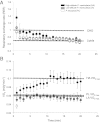Regulatory changes contribute to the adaptive enhancement of thermogenic capacity in high-altitude deer mice
- PMID: 22586089
- PMCID: PMC3365185
- DOI: 10.1073/pnas.1120523109
Regulatory changes contribute to the adaptive enhancement of thermogenic capacity in high-altitude deer mice
Abstract
In response to hypoxic stress, many animals compensate for a reduced cellular O(2) supply by suppressing total metabolism, thereby reducing O(2) demand. For small endotherms that are native to high-altitude environments, this is not always a viable strategy, as the capacity for sustained aerobic thermogenesis is critical for survival during periods of prolonged cold stress. For example, survivorship studies of deer mice (Peromyscus maniculatus) have demonstrated that thermogenic capacity is under strong directional selection at high altitude. Here, we integrate measures of whole-organism thermogenic performance with measures of metabolic enzyme activities and genomic transcriptional profiles to examine the mechanistic underpinnings of adaptive variation in this complex trait in deer mice that are native to different elevations. We demonstrate that highland deer mice have an enhanced thermogenic capacity under hypoxia compared with lowland conspecifics and a closely related lowland species, Peromyscus leucopus. Our findings suggest that the enhanced thermogenic performance of highland deer mice is largely attributable to an increased capacity to oxidize lipids as a primary metabolic fuel source. This enhanced capacity for aerobic thermogenesis is associated with elevated activities of muscle metabolic enzymes that influence flux through fatty-acid oxidation and oxidative phosphorylation pathways in high-altitude deer mice and by concomitant changes in the expression of genes in these same pathways. Contrary to predictions derived from studies of humans at high altitude, our results suggest that selection to sustain prolonged thermogenesis under hypoxia promotes a shift in metabolic fuel use in favor of lipids over carbohydrates.
Conflict of interest statement
The authors declare no conflict of interest.
Figures



References
-
- Conley KE, Porter WP. Heat loss from deer mice (Peromyscus): Evaluation of seasonal limits to thermoregulation. J Exp Biol. 1986;126:249–269. - PubMed
-
- Fontanillas P, Dépraz A, Giorgi MS, Perrin N. Nonshivering thermogenesis capacity associated to mitochondrial DNA haplotypes and gender in the greater white-toothed shrew, Crocidura russula. Mol Ecol. 2005;14:661–670. - PubMed
-
- Hayes JP, O'Connor CS. Natural selection on therogenic capacity of high-altitude deer mice. Evolution. 1999;53:1280–1287. - PubMed
-
- Chappell MA, Hammond KA. Maximal aerobic performance of deer mice in combined cold and exercise challenges. J Comp Physiol B. 2004;174:41–48. - PubMed
-
- Hayes JP, Chappell MA. Effects of cold acclimation on maximum oxygen consumption during cold exposure and treadmill exercise in deer mice, Peromyscus maniculatus. Physiol Zool. 1986;59:473–481.
Publication types
MeSH terms
Grants and funding
LinkOut - more resources
Full Text Sources
Other Literature Sources

